- Home
Welcome to Saddleworld!
The Saddleworld Website is a showcase
of a selected range of products that are available from any Saddleworld throughout Australia.If you would like to purchase a specific product, please contact your nearest store.
Click on Our Stores to find your nearest Saddleworld Store!
- Brands
- Products
Saddleworld Products & Brands
Saddles
Bridlewear
Tack Room
Horse Boots
- Kentucky »
- Eurohunter »
- Eurohunter »
Helmets
- Our Stores
Choose your nearest store
New South Wales
Queensland
South Australia
- Evandale »
- Gawler »
- Mt Barker »
- Mt Gambier »
- Wangara »
- Devonport »
- Launceston »
Western Australia
Tasmania
- News & Tips
- Catalogues
2017 Saddleworld Product Guide Out Now!
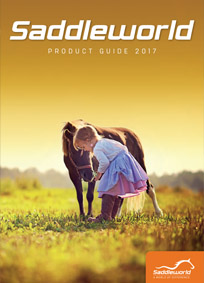
The 2017 Saddleworld Product Guide is out now.
Visit your nearest Saddleworld store and pick up your FREE copy today.
View the 2017 Product Guide Online Now!- About Us

Dressage Masterclass with Helen Langehanenberg
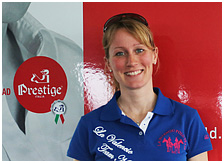
D&JWTS Dressage Masterclass -
Words as spoken by Helen LangehanenbergFor dedicated “dressage nuts” the Saddleworld Dressage Masterclass at D&JWTS (2014) with the World No 2 Dressage Rider, Helen Langehanenberg, (from Germany and sponsored by Prestige Saddles, Italia) promised to be a highlight of the event and a memorable learning experience for riders and trainers at all levels.
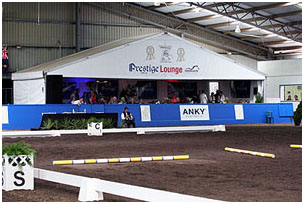 As the Prestige Saddle specialist, Saddleworld is well aware of this diminutive rider’s achievements and did not hesitate to get behind supporting her D&JWTS Masterclass. Helen has added another level of expertise to the Prestige brand and worked closely with their team to develop a saddle to meet her exact requirements. Saddleworld recently introduced the Prestige X-Helen to Australian riders and trainers and are sure that it will enjoy a very favourable response.
As the Prestige Saddle specialist, Saddleworld is well aware of this diminutive rider’s achievements and did not hesitate to get behind supporting her D&JWTS Masterclass. Helen has added another level of expertise to the Prestige brand and worked closely with their team to develop a saddle to meet her exact requirements. Saddleworld recently introduced the Prestige X-Helen to Australian riders and trainers and are sure that it will enjoy a very favourable response. Take a look at the Prestige Dressage range and learn more abut the X-Technology here … (http://www.saddleworld.com.au/brands/Prestige/prestigehome.html)
Pictured Above - The Prestige Hospitality marquee at D&JWTS and Below - Helen Talks Prestige saddles with David Sharp and Simon Mamouney from Saddleworld
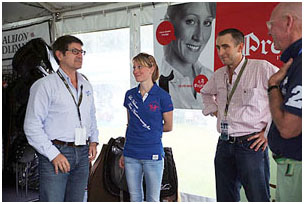 Saddleworld spoke to Helen at D&JWTS and she said, “I had a bit to do with Prestige Saddles while competing in Europe and I like their saddles very much. I wanted to create a saddle that was very soft for the rider and the horse and made from leather that provides comfort and grip. The leather is not slippery and gives the rider a very secure seat … this is important for riding young horses. The saddle I have developed with Prestige, is designed to fit well and I do not need to use gel to achieve a good saddle position. This saddle allows the horse’s shoulder to move freely – I love it!”
Saddleworld spoke to Helen at D&JWTS and she said, “I had a bit to do with Prestige Saddles while competing in Europe and I like their saddles very much. I wanted to create a saddle that was very soft for the rider and the horse and made from leather that provides comfort and grip. The leather is not slippery and gives the rider a very secure seat … this is important for riding young horses. The saddle I have developed with Prestige, is designed to fit well and I do not need to use gel to achieve a good saddle position. This saddle allows the horse’s shoulder to move freely – I love it!” 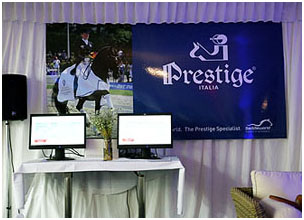 Helen has added another specialist dimension to this brand and joins an illustrious team of Prestige riders including such greats as Meredith Michaels-Beerbaum, Ludger Beerbaum, Michel Robert, Anna Sophie Fiebelkorn, Imke Schellekens Bartels, Nicola McGivern, Hinrich Romeike, Clarke Johnstone and the rider of the Aussie showjumper Belcam Ava, Susanna Bordone many other rider endorse Prestige – go to their web site to read the testimonials.
Helen has added another specialist dimension to this brand and joins an illustrious team of Prestige riders including such greats as Meredith Michaels-Beerbaum, Ludger Beerbaum, Michel Robert, Anna Sophie Fiebelkorn, Imke Schellekens Bartels, Nicola McGivern, Hinrich Romeike, Clarke Johnstone and the rider of the Aussie showjumper Belcam Ava, Susanna Bordone many other rider endorse Prestige – go to their web site to read the testimonials.Above - Electronic scores in real timewee available in the Prestige Lounge.
Helen Langehanenberg has notched up many outstanding wins with her outstanding Westfalian stallion Damon Hill NRW, (by Donnerhall from a Rubenstein mare) … including:
Team silver medal at the European Championships in Rotterdam in 2011
Team silver medal at the London Olympic Games in 2012
Team gold medal at the 2013 European Championships at Herning
Individual silver medal at the 2013 Grand Prix Freestyle in Herning
1st place in the Dressage final at the 2013 Reem Acra FEI World Cup at Gothenburg
German National champion in 2012 and 2013
1st in the Grand Prix and the GP Freestyle at Neumunster in February 2014
1st in the CDI 4* and the Grand Prix Special at Dortmund March 2014.
In 2014 Helen achieved her highest score ever, riding in her new Prestige X-Helen saddle.
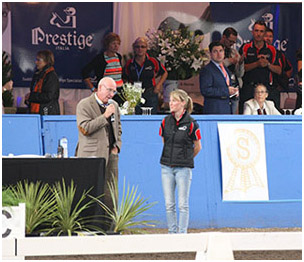 For her Prestige Australian Masterclass, Helen was introduced by NSW based FEI Rider, Judge, Trainer and Master of Ceremonies Roger Fitzhardinge and she then spent 2 hours working with 6 riders, who are training at every stage of dressage from Young Horse through to Grand Prix.
For her Prestige Australian Masterclass, Helen was introduced by NSW based FEI Rider, Judge, Trainer and Master of Ceremonies Roger Fitzhardinge and she then spent 2 hours working with 6 riders, who are training at every stage of dressage from Young Horse through to Grand Prix.Above - Roger Fitzhardinge Introduces Helen Langehanenberg
Helen’s first rider was Victorian Sharyn McCombe who is well known for her success with many top horses and ponies. She is a Victorian Squad member on the outstanding Yarramee B Bear by Northern Congress from Northern Celicia.
Sharyn was very excited to be chosen to participate in Helen’s dressage Masterclass and explained how this came about., she said. “Riders were invited to register their interest and from the details they provided to the organising committee, a long list was formed.”
“These riders brought their horses to Werribee Park on Wednesday 26th March to work with Helen and she then made her decision about the 6 horses that she felt would make ideal subjects for the lessons in her Masterclass.”
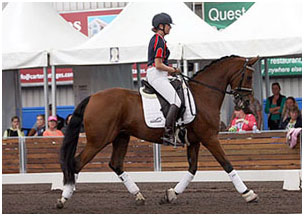 Sharyn rode the beautiful 4 YO Yarramee Poetry by Royal Hit from Northern Celicia ll (full sister to a mare of the same name to reach Grand Prix with her rider/owner Vicky Robertson).
Sharyn rode the beautiful 4 YO Yarramee Poetry by Royal Hit from Northern Celicia ll (full sister to a mare of the same name to reach Grand Prix with her rider/owner Vicky Robertson).Above - Sharyn McCombe and Yarramee Poetry
Sharyn’s young mare was a little overwhelmed by the atmosphere and it was interesting to see what Helen advised Sharyn to do to encourage confidence and obedience. “Keep her steady in the reins, keep a steady contact so that she feels more secure and comfortable. Sharyn, look how much is possible, not the problems.”
“It DOES NOT have to be perfect. try not to give up the contact” … the mare started to accept and Helen added, “It is possible now … do not forget the riding, Sharyn.”“The transitions need to be prepared but not backwards, wait and keep it forward. She is still a bit scared, don’t give the reins, it does not matter what she does, even if she is nervous, she must learn to accept the steadying influence of the contact – she will get confidence from this.”
It was clear to see that Sharyn’s lovely 4 YO mare needed to have a confident and positive contact to the bit in order to control her nerves and keep her focussed on the rider. As we saw the problems often encountered with young horses, this was a very worthwhile example of the correct management of a finely bred and reactionary horse.
Next to go was the lovely bay gelding Remington, ridden and owned by Georgia Connolly.
Below - Georgia Connolly and Remington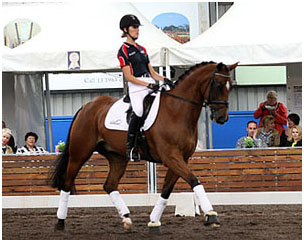 Helen shared some ideas about the nature of horses and commented, “If the horse is not tired, it loves to work and if your horse likes to trot then start with TROT … if your horse likes to canter, then start your work with CANTER.”
Helen shared some ideas about the nature of horses and commented, “If the horse is not tired, it loves to work and if your horse likes to trot then start with TROT … if your horse likes to canter, then start your work with CANTER.”“Sit and use your legs to collect and make sure that both legs are working equally. Sit … close your legs … you are asking the horse to close from behind and engage the hind legs … forward thinking!”
“Sometimes, LESS IS MORE! Before you change something in front, you must engage the hind legs.”
“Use the corners. Go into the corner and flex him around your inside leg and then ride him forward to the outside rein. Straighten your horse to the outside rein, it is THIS that makes natural self-carriage.”
“Now Georgia, we will try a shoulder-in. I want to see three legs, he is now offering too much and cannot maintain his balance and self-carriage. Correct the carriage and bending to restore the balance until he wants to stretch into the contact and follow your aids. You need MORE bending and LESS crossing to maintain balance and self-carriage. The rider must ask … WHAT TO I HAVE??? WHAT DO I NEED???”
“SOME HORSES HAVE DIFFICULTIES WITH FLEXION AND BENDING AND SOME HAVE PROBLEMS WITH THE TWO TRACK MOVEMENT – each horse requires individual step by step preparation to overcome these problems.”
“We will try some half pass – remember that in half pass, the diagonal line is now your track. Take the short diagonal … do not think of half pass, just think of haunches in. Georgia, your horse is responding very well.”
“Choose your line and step by step make a half pass out of it.”
“After collection, it is important to go forward and allow a swinging trot. Now, change the rein and go on the short diagonal and prepare the half pass by doing a shoulder-in and then JUST put his haunches in!”
“Change from shoulder-in to haunches in – always making sure that he is working from behind, then you can work from haunches in to shoulder-in.”
Georgia, “Sometimes you do not have enough hind legs and sometimes you have too much. You need to adjust and consider the technique. Ask for more expression and then let him out again, this makes the horse supple and more responsive.”
“If you encounter problems in the half pass, do not think of going more sideways, think of going more forward. We do not want to see a change of rhythm, we want to see the horse fresh and motivated to go.”
Georgia, really think, “WHAT WILL I WORK ON TODAY?” Make a plan and try to base your work on this, but do not always stick rigidly - assess the horse’s response – they do not come out the same way every day.”
Georgia left the arena and the next to enter was Elliot Patterson riding the imported chestnut mare Boronia, by Brightling.
Below - Elliot Patterson and Boronia
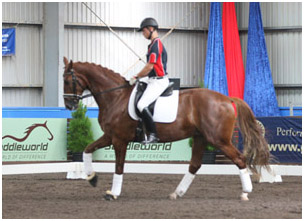 Helen explained, “Elliot is working on the flying changes with this horse and sometimes it can be very good and sometimes, not so good!”
Helen explained, “Elliot is working on the flying changes with this horse and sometimes it can be very good and sometimes, not so good!”“As soon as the horse opens her neck and works from behind we can think working canter and then collected. We need to see that the horse is stretching towards the bit, you need to get the half halts more equal to both reins.”
“Elliot, don’t allow her to make herself stiff – explain to her, NO I DON’T WANT IT LIKE THIS (jumping in the air and stiff) … if it takes too long, then it takes too long, the rider needs to sit, feel and think.”
“When you have bending, you can take he contact forward and lead her to the upwards position, then make the canter smaller, but from behind – we don’t want any stiffness – don’t hold her, bend her a little and keep her active.”
“Elliot, give little half halts, the horses have to find out how it works and how to use their body! Bend her, then let her find her own balance.”
“We will now try the flying changes. Come and choose a straight line and wait for the right moment. Wait til you feel that the horse can change, ask the horse to wait for your aids, prepare, but still keep going forward.”
“Take the horse in counter canter and straight on the long side of the arena and make the canter smaller. When the feel is right, ask for the change. Keep the weight on the horse’s hind legs and … when you ask for something new, don’t insist on a perfect head carriage – it takes time!”
“Elliot, collect more to bring the weight under her centre of gravity and make sure she is really jumping with the hind legs engaged. It is good when the horse is working from behind, other problems of the early lessons will improve.”
“The more you let her stretch, the more you have to engage her from behind." After this collected work, we must allow her to stretch. Good, she is still searching for the contact.”
Elliot Patterson allowed the lovely dark liver chestnut mare to stretch and relax as Sara McDonald, rode another lovely mare – Racquel, by Rubinero, joined him in the arena. This mare is an embryo transfer foal, bred and owned by Jane Bartram. Sara has enjoyed great success with her mare Adlanta Rose by Rotspon from another FEI mare that was trained and owned by Sara, Adloo Georgia, by the imported French Anglo Arab Victorieux.
Below - Sara McDonald and Racquel
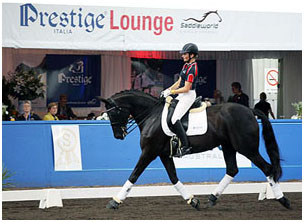 Helen said, “We will start this horse in the canter – come on, ask for more bending, then ask for the beginning of collection. Keep it easy, no matter what happens – she tries to escape the aids. It is important that horses accept the bending – allow, then take the reins like you are playing a game – take less collection and let her play with the bending.”
Helen said, “We will start this horse in the canter – come on, ask for more bending, then ask for the beginning of collection. Keep it easy, no matter what happens – she tries to escape the aids. It is important that horses accept the bending – allow, then take the reins like you are playing a game – take less collection and let her play with the bending.”“The horse needs to be round and also around our inside leg – she does not need to be perfect – explain it to her and continue to play with the aids until the horse understands what you want. Good, she is getting supple and accepting your aids.”
“That is what I like as well, that you work the horse a little like a young horse at times (give and take the reins and change the frame) you must be clear with the aids so that the horse knows what to do and likes to work.”
“Sara, you do not have to push all the time, when you reach a point, be soft, this is good for the horse. Now we will go the other way and start with bending and flexion. Tell the horse, “you have not done something wrong, I just want you more from behind and bending!”
“Ask for a little bit more bending and take the contact and wait … keep the activity. Say to the horse “YES, IT IS possible – I will not make it hard for you, I will make it easier!
“The more you collect, the more you want to feel the jump in the canter, see that she is not making herself stiff. YA!!! Now let her go forward and let her stretch. Sara, when you do the transitions to walk, you must make sure that the last stride of the canter IS a canter stride in 3 beat down to walk which IS in 4 beat.”
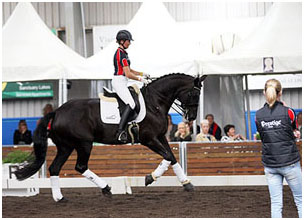 “Play with the trot, improve the trot to make the hind leg more active. Your horse is getting tired so allow her to show less in the frame, but stay active.”
“Play with the trot, improve the trot to make the hind leg more active. Your horse is getting tired so allow her to show less in the frame, but stay active.”“If you want to improve the horse’s condition (strength) you must ask for activity a bit more forward.”
Above - Helen Langehanenberg wears her Prestige vest as she helps Sara McDonald and Racquel
Above - Helen Langehanenberg wears her Prestige vest as she helps Sara McDonald and Racquel.
“You only ask for as much collection as you can get from behind, active first, with seat and leg and allow the neck forward for a break.”
“Always give your horse FREE days, do not always do dressage – keep it interesting for the horses.” Sara seemed pleased with the result and her mare looked sensational.
Popular Victorian rider Antony Bartlett and his Grand Prix gelding Lexington Nite Cap were next in, and Helen smiled as he enjoyed rousing applause from his numerous fans. Ant has owned this horse since it was a 3 YO and was purchased in partnership with the late Kitty Stapleton. Kitty was a much loved and respected Victorian dressage rider and she would be enormously proud to see how well they have progressed.
Helen said, “First get him more active and open and see that he is in self carriage … then ask for more activity. You should feel that the horse “grows” under you. Be sure you have equal flexion and bending to both sides. When he starts to swing, you can ask for a bit more collection from behind.”
“Antony, ask for more bend and activity from behind and then you can make some passage steps … plan WHICH passage steps – you can make them more collected and then more open. Step by step, he will start to swing – always engage the hind legs.”
“When you want to get more reaction, you can try to do this in the passage to help improve the clarity of the two beats. Do not always do it on a straight line, use turns and keep the hands in front and SWING into passage from behind – from this preparation we can progress to the piaffe work.”
“From the trot, we will think of Piaffe, use the energy of the trot and do some quick transitions to piaffe, trot, piaffe … come on, trot … think of extension in the piaffe to create energy.”
“With lazy horses. It is important to trot – piaffe – trot- NOT pulling backwards – think forward!”
“Ant, make your reins shorter and take your hands forward – soft hands!”
“If the horse turns a little, then allow it. In the beginning we can allow the horse to be comfortable. Be sure you have equal bending and flexion to both sides … now allow him to stretch and be sure not to ask for too much at first, be happy with less expression and less activity. We must give the horse time to develop and he must learn to get a little more sensitive.”
Antony was all smiles as he rode from the arena, he passed Shanon McKimmie, riding her own black, imported gelding Ambassi, who is now stepping up to begin his Grand Prix career. A highlight for the young Victorian rider was winning the prestigious Marcus Oldham Aachen Challenge in 2010 and she has been a top three placegetter on two subsequent occasions. Shanon trained her winning horse up to Grand Prix and is enjoying the journey a second time around.
Below - Shanon McKimmie and Ambassi
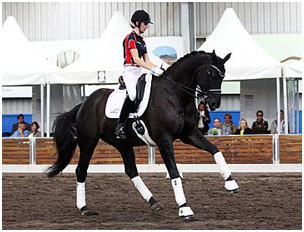 Ambassi was imported by Mary Hanna and is by the fancied German sire Samba Hit.
Ambassi was imported by Mary Hanna and is by the fancied German sire Samba Hit. Helen Langehanenberg started this session with canter so that we could look at the important considerations when preparing the horse for canter pirouettes.
“Shanon, we will start today with the half pass work, take the quality of the jump in the canter to the half pass … with a through and forward tendency.”
“Have the feeling that the horse jumps towards the inside rein, always go forward towards the flying change and then make the change with the support of the new inside leg.”
“In the zig-zag canter, you should have the feeling that you ride the canters together and be careful to ride the last stride before the flying change STRAIGHT." It is very important to count the canter strides.”
Helen confirmed enthusiastically, “With this horse it was fluent and forward!”
“You have to ask …”how much forward can I go … and how much collection do I need … to get the straightening, change of bend and new change.”
“Make sure that the horse’s canter steps stay the same as the normal collected canter – always keep the forward tendency and from there we can go on to a working pirouette.”
“Shanon, come onto the centre line and keep the shoulder-in tendency, have the feeling that you will keep the quality of the canter, but do not go one centimetre forward, do the pirouette exactly on the centre line. Be sure you can maintain the activity, use the short side of the arena to collect and improve the quality of the canter.”
“Shanon, the changes were lovely and forward.. Try the two’s. They were straight, but it is OK at this early stage if they are a little swinging – for a young horse he is doing a really good job.”
“Lets try for a couple of ones on the side line. Shanon, they were very good ones on the side line.”
“That is it with horses, they ask questions about which is the best way, this horse is not perfect, but he is going on a very nice way of training.”
“Now we will go back and do some trot work and it is the same – we want to engage him a bit more. We will go into passage … this horse likes to do this!”
“Allow him to feel his rhythm – get the feeling that you are trotting over a long row of cavalettis, make him rounder NOT shorter, keep the swinging rhythm.”
“Collect the trot into the piaffe work … trot … piaffe … trot … and always in piaffe, feel that the rhythm of the trot is secure and think of an extension.”
“The transitions are the important thing – this horse knows the technique and we have to encourage him to be more active. Use the whip on his croup, he has to learn to swing and get more impulsion.”
“Shanon, don’t make the horse too tired – this work needs time.”Below - Saddleworld's David Sharp thanks Helen Langehanenberg for a fantastic session on behalf of the Australian riders and spectators.
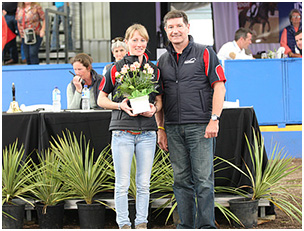 Helen finished off her session and the quietness of the past two hours was broken by the enthusiastic applause. The spectator feedback was excellent, with people acknowledging Helen’s love of horses and sympathetic approach to training – she reminded us that “Less is more” and when the horse is properly prepared for the lessons through adequate training and preparation of the training scale, they can work with ease and enjoy the dressage journey with their rider.
Helen finished off her session and the quietness of the past two hours was broken by the enthusiastic applause. The spectator feedback was excellent, with people acknowledging Helen’s love of horses and sympathetic approach to training – she reminded us that “Less is more” and when the horse is properly prepared for the lessons through adequate training and preparation of the training scale, they can work with ease and enjoy the dressage journey with their rider.Thankyou Helen Langehanenberg, your Australian visit will be with us all for a long time, through the wisdom you imparted at this Saddleworld sponsored Masterclass.












 Brands
Brands
Ammo
Eurohunter Rugs
Grazioli Boots
Kentucky Horseware
PDS Carl Hester Collection
Pessoa Saddles
Prestige Saddles
Thorowgood
Trainer’s
Sponsored Events
Saddleworld Melbourne International 3DE
Saddleworld Australian Youth Showjumping Championships
Saddleworld Brisbane CDI
PSI Dressage & Jumping with the Stars
Copyright © 2013 Saddleworld Pty Ltd.
Taking care of all your horse needs. Saddles, horse rugs, riding equipment, bridles, saddlery, clothing, veterinary supplies. All Rights Reserved.
Home | Privacy Policy | Pricing Policy | Contacts | Join - Products



